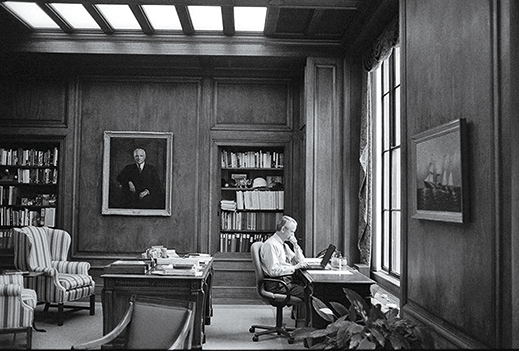Remembering Charles M. Vest
In December, MIT lost a remarkable champion with the death of its 15th president, Charles M. Vest, 72, who led the Institute through striking change and growth from 1990 to 2004.

During Vest’s presidency—the third-longest in the Institute’s history—MIT made major innovations in education and research, strengthened its commitment to diversity, transformed its campus, and developed ties with academic, government, and industry partners around the world. MIT’s endowment nearly quadrupled, from $1.4 billion to $5.1 billion.
“Through its own work, and especially through the lives and works of its graduates, a great university can strive to make the world well,” Vest wrote in 2004. “The knowledge we generate, the things we come to understand, and the devices we build can improve health, economies, security, and the quality of life.”
A mechanical engineer by training, Vest spearheaded expansion into fields including brain and cognitive sciences, nanotechnology, genomic medicine, biological engineering, and new media. The McGovern Institute for Brain Research, the Picower Center for Learning and Memory, the Institute for Soldier Nanotechnologies, and the Broad Institute were all established during his tenure. He also fostered major international ventures, including the Singapore-MIT Alliance.
“Chuck Vest set an exceptional standard of intellectual clarity, moral courage, and generosity of spirit,” MIT president L. Rafael Reif says. “And there was no better example of his vision and values than the creation of MIT OpenCourseWare—the simple, elegant, unprecedented idea that MIT should make all of its course materials available online to anyone in the world, free.” Reif calls OCW “the foundation and inspiration for everything we are striving to achieve with edX and MITx.”
On campus, Vest was committed to improving student life and learning: his innovations include a restructured housing policy, the introduction of cellular and molecular biology as a core undergraduate requirement, and the MacVicar Faculty Fellows Program. But he was also a regular presence in Washington, where he “served with distinction as an ambassador and spokesman for science,” says President Bill Clinton. “Chuck Vest was both a product and a champion of this nation’s powerful scientific and engineering community.” He served on the President’s Council of Advisors on Science and Technology, chaired the Task Force on the Future of Science Programs, and was the National Academy of Engineering’s president. In 2006, he won the National Medal of Technology.
“Chuck Vest’s irrepressible good humor and easy laughter mixed effortlessly with his earnest, persistent pursuit of the right path in all things,” says Susan Hockfield, who succeeded Vest as MIT’s president.
In 1998, Vest forthrightly acknowledged long-standing imbalances cited by senior women faculty in the School of Science and supported measures to address them. A candid public report was ultimately released, stimulating examination of gender equality at universities across the country. Vest also bolstered MIT student and faculty diversity, and he was a staunch advocate of need-based financial aid.
Vest’s leadership physically reinvigorated MIT’s campus. When he left office, one-quarter of the Institute’s square footage had been constructed during his term, including the Ray and Maria Stata Center, Simmons Hall, the Albert and Barrie Zesiger Sports and Fitness Center, and the Media Arts and Sciences building.
“Chuck Vest was, above all, an extraordinary human being: not only was he perhaps the most respected figure in higher education, he was a man of extraordinary decency, integrity, and grace,” says Lawrence S. Bacow, who was MIT’s chancellor under Vest before being named president of Tufts University in 2001. “His principled courage stood him, and MIT, in good stead on countless occasions when the going got tough, and he was a good friend and extraordinary mentor to so many of us.”
A memorial service will be held at 4:30 p.m. on March 6 in Kresge.
Keep Reading
Most Popular
Large language models can do jaw-dropping things. But nobody knows exactly why.
And that's a problem. Figuring it out is one of the biggest scientific puzzles of our time and a crucial step towards controlling more powerful future models.
The problem with plug-in hybrids? Their drivers.
Plug-in hybrids are often sold as a transition to EVs, but new data from Europe shows we’re still underestimating the emissions they produce.
Google DeepMind’s new generative model makes Super Mario–like games from scratch
Genie learns how to control games by watching hours and hours of video. It could help train next-gen robots too.
How scientists traced a mysterious covid case back to six toilets
When wastewater surveillance turns into a hunt for a single infected individual, the ethics get tricky.
Stay connected
Get the latest updates from
MIT Technology Review
Discover special offers, top stories, upcoming events, and more.